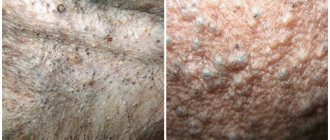Rash on the stomach of a cat
Domestic cat 9 years old. Doesn't go outside, but walks on the unglazed balcony. A red rash appeared on the cat's abdomen. At first it was a little, but now it has spread throughout the entire stomach. The nipples are sore. He often scratches and licks his belly. No further deviations in behavior were noticed. Specks of different sizes, the middle seems to be dried out. If you have information on Orenburg clinics, where is the best place to go?
Domestic cat 9 years old. Doesn't go outside, but walks on the unglazed balcony. A red rash appeared on the cat's abdomen. At first it was a little, but now it has spread throughout the entire stomach. The nipples are sore. He often scratches and licks his belly. No further deviations in behavior were noticed. Specks of different sizes, the middle seems to be dried out. If you have information on Orenburg clinics, where is the best place to go?
Types of rash and general symptoms
Rashes appear in the form of tubercles, papules, ulcers, blisters, blisters, spots, and hemorrhages under the skin. Peculiarities:
- tubercles form without cavities, develop into ulcers, and after healing a scar remains;
- papules, or nodules, are cavityless formations and disappear without leaving traces;
- ulcers consist of a cavity filled with purulent fluid;
- blisters do not have a cavity, look like pink round rashes, and are itchy;
- the vesicles contain a cavity containing serous or bloody contents and are small in size;
- spots vary in color and size, they can be pink, red, purple;
- hemorrhage - accumulation of blood after the rupture of small vessels with the formation of a cavity.
Additional manifestations of a rash on a cat’s stomach: scabs or scales, ulcerations, erosions, scratching, scarring, pigmentation.
Symptoms accompanying skin rashes: severe itching; meowing while scratching; thinning the coat; irritability, aggressiveness. At the same time, the surface of the skin is dry and cracks appear. Manifestations look different in each animal, depending on individual characteristics: age, gender, health status and immune system.
Dermatitis is the main cause of rashes
Inflammation of the skin occurs in an acute or chronic course. In the first case, it is easy to cure the animal if you contact a veterinarian in time. If proper and timely treatment is not provided, the acute form becomes chronic. It is difficult to treat. Types of dermatitis:
- simple – contact with the stimulus. It rarely develops, since the skin is protected from external influences by a dense coat;
- allergic – the body’s reaction to an allergen. The immune system begins to fight the irritant, which causes various manifestations on the body.
Dermatitis is provoked by various factors, which determine the characteristics of the rash and other symptoms.
Dermatitis
Among skin diseases in cats, dermatitis especially deserves mention. Depending on the causes of its occurrence, it is divided into the following types:
- thermal;
- chemical;
- traumatic and medicinal;
- parasitic and infectious.
Regardless of the type of disease, purulent inflammation of the skin is observed. A serous secretion or ichor may also appear. The most common is miliary dermatitis. It is an allergic reaction that occurs in response to the bites of blood-sucking parasites.
Symptoms of dermatitis can vary. Basically, the disease manifests itself in the form of various redness, cracks in the skin, swelling, purulent discharge, and peeling of the skin.
Treatment is selected depending on the cause of dermatitis, as well as the severity of the inflammatory process. For injuries, apply external dressings with ointment, which has an antiseptic and astringent effect. Preparations with propolis have a good healing effect. If the damage is caused by chemicals, then initially it is necessary to neutralize its destructive effect.
Factors for the appearance of dermatitis and their signs
Factors leading to the appearance of a rash on a cat's stomach:
- Fleas. These insects cause severe itching, scratching, and redness of the skin. The time of year in which flea dermatitis most often develops is summer, but there is a possibility of rashes appearing in winter. The rash caused by fleas can become covered with scabs, erosions, and become moist.
- Ticks. The bite leads to the formation of rashes, swelling, inflammation and itching. An allergic reaction often spreads to the entire body of the pet.
- Feed. Food allergies are common in pets. Signs: rash, itching, swelling. The reaction develops rapidly or with a delayed effect.
- Fungi. Infection with a fungal infection leads to the development of lichen. It is accompanied by hair loss, the appearance of formations on the skin, and itching.
- Pemphigus. Refers to autoimmune diseases in which one's own immunity destroys healthy cells. Bubbles, pustules, and crusts form throughout the animal’s body. The affected areas are red. Appetite decreases, exhaustion is observed.
We recommend reading: Medicines for Dog Poisoning
If you notice such signs in your pet, you should immediately contact a veterinarian, who will prescribe the appropriate treatment.
Types: causes and symptoms
How to recognize ringworm?
Veterinarians claim that the causative agent of this pathology poses a threat to the health not only of pets, but is also dangerous to people. Even 50 years ago, pets that became infected with ringworm were euthanized because the pathology could not be treated.
Infection in cats occurs through household contact, or the virus can be located on the owner’s shoes or clothing. The dermatological disease poses the greatest danger to kittens and young felines, since they have weak defense mechanisms of the immune system. The disease can be recognized in cats by the following symptoms:
- the appearance of small spots on the body that are round in shape;
- irritation and peeling of the skin at the site of sore formation;
- rashes that first appear near the tail, after which they spread to the ears and paws;
- severe itching, as a result of which the pet constantly itches and licks itself.
Symptoms of bedsores
Good hygiene reduces the risk of developing skin diseases.
Similar skin rashes are recorded in cats and kittens that lead an inactive lifestyle and constantly lie in one position. Dermatological disease can also manifest itself in pets who have undergone surgery and are forced to take one position. Skin problems are associated with the process of decay and death of epidermal tissue. The disorder also often occurs in an old cat that does not move much. With the development of bedsores, the owners observe redness on the skin, in place of which small crusts soon appear.
Features of acne in pets
Cat rashes are practically no different from a similar dermatological disease that occurs in humans. The following reasons can affect the disease:
- improper care of your pet;
- severe or frequent stress;
- unbalanced diet.
First, the owner observes that the cat’s skin is red or there are problems with its fur. Subsequently, subcutaneous pimples of a reddish hue are recorded, which cause severe itching in the pet. At the site of the formations, scratching and small wounds occur, which become infected, causing large ulcers and ulcers. With advanced acne, a strong inflammatory reaction occurs in the cat, which needs to be treated as soon as possible.
How does eczema manifest?
The ulcers become inflamed, causing severe itching.
The dermatological disease may be bacterial in origin or caused by the collar being too tight. Eczema in cats can be weepy or appear as dry patches on the skin. The disease occurs in the acute phase or has a chronic course. There are the following reasons that influence the appearance of eczema in cats:
- deviations from internal organs;
- malnutrition;
- mechanical damage;
- insect bites;
- contaminated surface of the epidermis;
- allergic reaction;
- incorrect metabolic processes;
- hormonal disbalance.
Eczema in pets is often genetic. It is important to understand that this form of dermatological disease is more difficult to treat and it is rarely possible to get rid of the symptoms completely.
The following signs are characteristic of cat disease:
- red skin that is very itchy;
- affected areas are hot to the touch;
- the formation of small bubbles containing exudate;
- the appearance of a crust causing peeling;
- unpleasant odor from ulcers with weeping eczema.
Signs of an allergic reaction
Poor quality food can cause allergies.
Often, dermatological skin diseases in cats occur due to the negative influence of a certain irritant. A negative reaction may occur after eating certain foods or feeds, due to taking medications, or when exposed to dust, dirt and other allergens. Allergies in cats can be recognized by the appearance of small rashes on the epidermis, causing itching and burning. For dermatological sores, sometimes no treatment is required, but it is enough to eliminate the effect of the irritant on the hair area.
What is scabies?
Some skin diseases in cats are highly contagious and can be transmitted to people. These diseases include scabies, which is caused by a microscopic mite. The spread of infection occurs quite quickly and pathogenic microorganisms first appear in the head and neck area, and then spread to other parts of the body. Most often, symptoms occur in old cats or tomcats or in weakened pets. Owners may examine their pet at home and notice the formation of small wounds, which, when scratched, become large purulent abscesses.
Miliary form of dermatitis
As a result of flea activity, irritation appears.
This feline skin disease leads to irritation of the epidermis, and various factors influence the pathology. In most cases in cats, the disease is associated with the bite of fleas or other small parasites. Pathology in kittens and adults also manifests itself when exposed to the following causes:
- allergies to various irritants;
- bacterial infection;
- fungal infection;
- increased sensitivity to parasites of the cat’s gastrointestinal tract;
- autoimmune diseases;
- unbalanced diet;
- imbalanced hormones.
This type of skin disease in cats is characterized by the appearance of several nodules at once, which have a solid structure. In some pets, miliary dermatitis affects a small area of the epidermis, while in others, a large part of the body may be damaged. In most cases, the cat is bothered by itching and flaking, which sometimes cannot be eliminated with medications. In this case, the animal constantly itches, which causes infection and complicates the skin disease.
The essence of demodicosis
The parasite feeds on the cat's skin.
A crust that forms on the epidermis of a cat may signal the development of a similar disease, which is caused by a tick, namely its decay products after a bite. The skin disease is characterized by a rapid course and is accompanied by symptoms such as:
- the appearance of abscesses that cause severe pain;
- redness of the epidermis;
- itchy sensations.
Demodicosis in cats cannot be completely cured, but with the help of medications it is possible to temporarily relieve the symptoms of the skin disease.
Other diseases
A cat’s rash on the stomach and other areas of the skin can be the result of pathological processes, such as:
- erythema;
- Cushing's syndrome;
- alopecia of psychogenic type;
- otodectosis;
- cheyletiosis;
- notoedrosis.
Diagnosis and treatment
To identify the cause of a rash on the cat’s stomach, the veterinarian will perform the following procedures: taking an anamnesis (questioning the owner), external examination, tests (blood, urine), scraping the skin. If a cat is affected by fleas, anti-flea medications are prescribed: shampoos (Bars, Fitoelita, Lugovoi), drops (Frontline, Stronghold, Bars, Advantage), sprays (Bars, Frontline). For prevention, it is recommended to wear a flea collar. For ticks, the same drugs are used. If the cause of the rash is an allergy to food, the doctor prescribes a diet of natural products or hypoallergenic food. It is better to give dietary meat (chicken, turkey, rabbit).
For lichen, antifungal agents are prescribed: local (Fungin, Clotrimazole, YaM, Fukoricin, Imaverol), Shampoos (Nizoral, Sebozol). In severe cases, you will need tablets: Ketoconazole, Griseofulvin, Flucanazole.
To treat pemphigus in cats, strong hormonal drugs are prescribed: Prednisolone, Dexamethasone. General remedies: keratolytic shampoos, Vishnevsky's liniment, naphthalan ointment, for complicated eczema (Advantan, Sinaflan, Triderm). Antihistamines for any type of allergy: Cetirizine, Tavegil, Fenistil.
Skin rashes appear frequently in cats for various reasons. The main thing for the owner is to detect symptoms in time and contact a veterinarian.
Inflammation of the skin occurs in an acute or chronic course. In the first case, it is easy to cure the animal if you contact a veterinarian in time. If proper and timely treatment is not provided, the acute form becomes chronic. It is difficult to treat. Types of dermatitis:
Symptoms of acne
The following symptoms are typical for this disease:
- Redness of the skin;
- The appearance of swelling in the area where blackheads accumulate;
- Development of ulcers, hair loss;
If left untreated for a long time, these symptoms often cause anxiety, the pet becomes nervous and irritable, and may show aggression. In addition, the cat begins to scratch the damaged area, thereby increasing the risk of a new infection and deterioration in overall health.
An examination by a specialist and taking a scraping will help rule out the presence of diseases with similar symptoms. These include:
- Diseases of the stomach and liver. Caused by poor diet or complications after an illness. Lead to rashes all over the cat's body.
- Demodecosis. Characterized by the presence of subcutaneous mites. It is characterized by the appearance of ulcers, itching and hair loss. Easily transmitted to other animals.
- Allergy. Common causes are a reaction to food, collar, litter. It is characterized by the appearance of pimples or black spots in the cat’s fur, redness of the skin and itching.
- Lichen. The development is provoked by a fungus, as a result of which peeling and rashes appear on the cat’s skin, which lead to itching and baldness.
In addition to the above reasons, a strong argument indicating the need for examination by a veterinarian is a deterioration in the pet’s general health, refusal to eat, vomiting, lethargy and constant drowsiness. After conducting a visual examination, the doctor will prescribe the necessary examination, which may include various tests - skin scraping, fungal exclusion analysis and biopsy.
Causes of a rash on the stomach of a dog
The appearance of rashes on a dog’s skin usually leads to the fact that the fur becomes dull, in some places it can even fall out, and the animal itself begins to itch. Moreover, this itching may not stop for almost a minute.
Naturally, the animal needs help. This causes him discomfort and can lead to quite serious health problems. After all, when scratching with its clawed paws, a dog can introduce an infection into the deeper layers of the skin, which will lead to the spread of infection, tissue inflammation and other problems.
Experts say that for any manifestation of a rash, even if you think it is normal, it is better to consult a specialist. This will help you not miss the beginning of something more serious.
Causes of rashes in dogs
Almost anything can cause a rash in dogs. For example, if an animal has fleas. Their bites will appear as small red spots, which are also very itchy.
The appearance of red, itchy spots can easily be caused by common food allergies, which usually occur in dogs in response to excessive protein intake. Therefore, first of all, it is worth checking the food.
It is a mistake to assume that protein is only found in canned meat. It is found in both poultry and fish. Therefore, try to create a diary of your pet's food and observe his reaction.
In addition, an allergy may occur to the detergent. For example, if you changed the shampoo that you washed your dog with before, etc.
What diseases does the appearance of a rash indicate?
A rash that appears on a dog can indicate a huge number of different diseases. This includes dermatitis, eczema, as well as lichen, scabies, giardiasis and other diseases.
Serious diseases that a rash may indicate include plague, tuberculosis, tumors, streptococcal and staphylococcal infections.
If you find a rash on your pet not only on the stomach, but also on the inside of the thighs, near the anus, on the head, nose, lips and gums, he most likely has pyoderma - a pustular disease of the skin. It usually manifests itself when staphylococci and streptococci penetrate deeper into the skin and begin to multiply there.
Pyoderma is increasingly being caused by freeze-dried food, unfavorable environmental conditions and a sedentary lifestyle of the animal.
We recommend reading: Cat Life Span
Treatment for rash
Naturally, you first need to cure the underlying disease that is causing the problems. Without this, the rash will appear again.
However, no one has canceled symptomatic treatment to alleviate the animal’s condition. The best option would be to trim the fur on the affected area. Firstly, the treatment will be more intense. Secondly, nothing will further irritate the animal’s skin.
Damaged areas of the skin will have to be treated with disinfectant solutions. Traditional drugs such as brilliant green, iodine, etc. will be good for treatment.
In advanced cases, you will have to give the animal a course of antibiotics. The doctor must tell you which one exactly.
Naturally, any disturbances in the dog’s condition lead to a decrease in immunity, so it would not be superfluous to include various vitamin complexes and immunomodulators in the pet’s diet. All this will help the dog’s body cope with the disease faster.
Serious diseases that a rash may indicate include plague, tuberculosis, tumors, streptococcal and staphylococcal infections.
Treatment of a pet for an ailment
After examination, a qualified specialist prescribes comprehensive treatment, which is carried out at home or in a veterinary clinic. It includes:
- Local processing. Tar soap, specialized shampoo, antiseptic solutions, and a bandage soaked in calendula tincture are used.
- Taking prescribed medications. Prescribed in more advanced cases, in the presence of the development of a secondary infection. A monthly intake of an individually selected vitamin complex is recommended.
- Injections. If necessary, medications are selected by the attending physician.
- Adjustment of the usual diet. During treatment and recovery, the pet is transferred to a low-fat diet.
You may be interested in: Gum inflammation in cats: symptoms, treatment and prevention
Cat rash
This article contains a lot of useful information, which makes it possible to better understand what you have to deal with in the most common cases and how veterinarians help cats, cats and kittens.
How to treat a rash in a cat along the spine, near the tail, ear, stomach, back
The rash may indicate miliary dermatitis, or in common parlance – cat mangy. It manifests itself in a rash all over the animal's body. Frequent spreaders of the disease are fleas. Therefore, treatment begins with the administration of anti-flea drugs.
If dermatitis is caused by an allergic reaction to pollen, room dust, or food, it is better to do a test to identify the allergen and eliminate your pet from it.
In any case, only a veterinarian can determine the cause of the disease and prescribe adequate treatment.
A cat has a rash on its hind legs, face and is constantly itching, what could it be and what can I do to help?
A rash on the animal's paws and face indicates miliary dermatitis. Caused by flea bites, tick bites, fungal diseases, allergic reactions.
For effective treatment, the root cause must be identified. Therefore, the animal is taken to the veterinary clinic. At home, it is necessary to keep the animal’s skin and fur clean and scrupulously follow the veterinarian’s instructions. At this time, the animal requires increased attention and good nutrition.
Rash in a cat after sterilization
If there was no rash on the animal’s body before the operation, the cause may be an allergic reaction to medications. Here, only a specialist can identify the cause and prescribe treatment.
Signs of an infection in a cat's mouth and how to treat it
The most common type of oral infection is gum disease. They are caused by herpesvirus, calcivirus, leukemia and immunodeficiency. The main symptom is loss of appetite. Associated symptoms are: inflammation in the mouth and tongue, bad breath and drooling, sometimes with traces of blood. Painful sensations can manifest itself in the fact that the cat rubs its mouth with its paw and resists attempts to examine it. Lymph nodes may be enlarged.
For treatment, you need to have your teeth professionally cleaned by a specialist. In uncomplicated situations, the oral cavity is treated with herbal decoctions (oak bark, chamomile) or antiseptic solutions (miramestine, chlorhexidine). The gums are also lubricated with dental ointments - Metrogyl Denta, and a special veterinary drug - Zubastik or Dentavedin.
In case of a serious infection, the cat is given antibiotics, for example, summed (¼ tablet)
The infection can be caused by the viral disease calcivirus, which can only be treated in a hospital setting.
What is an infection in a cat with ulcers on the tongue called and how to treat it at home
The appearance of ulcers on a cat's tongue can be caused by a calcivirus infection - calcivirus.
Treatment is best done in a hospital, an approximate treatment regimen: - Prescribing an antibiotic. — Treatment of ulcers with an antiseptic solution. — Treatment of the nasal cavity with saline solution. — Introduction of vitamins and immunomodulators into the diet. — A sick animal must be isolated from healthy ones and the room must not be kept dry.
A rash on the animal's paws and face indicates miliary dermatitis. Caused by flea bites, tick bites, fungal diseases, allergic reactions.
Ringworm
This is an infectious skin disease in cats, a photo of which shows the peculiarity of its course, provoked by mold fungi. It can affect not only animals, but also humans. Infection mainly occurs after close contact with a sick individual.
Fungal spores are very stable in the environment. At risk are mainly animals in a state of immune depression, those with a poor diet, elderly and young cats.
It is important to diagnose the disease in a timely manner, as it requires long-term, complex treatment. Among the main symptoms it is necessary to highlight the following:
- hair thinning;
- itching;
- the appearance of white flakes in the wool;
- Nails may become deformed and acquire a yellowish tint.
Treatment of ringworm should begin immediately after detection, as there is a high risk of human infection. To make an accurate diagnosis, you need to go to a veterinary clinic for examination.
For therapy, Miconazole or Thiabendazole ointment is prescribed. It is forbidden to bathe a cat that suffers from lichen, as this contributes to the spread of fungi throughout the animal's body.











